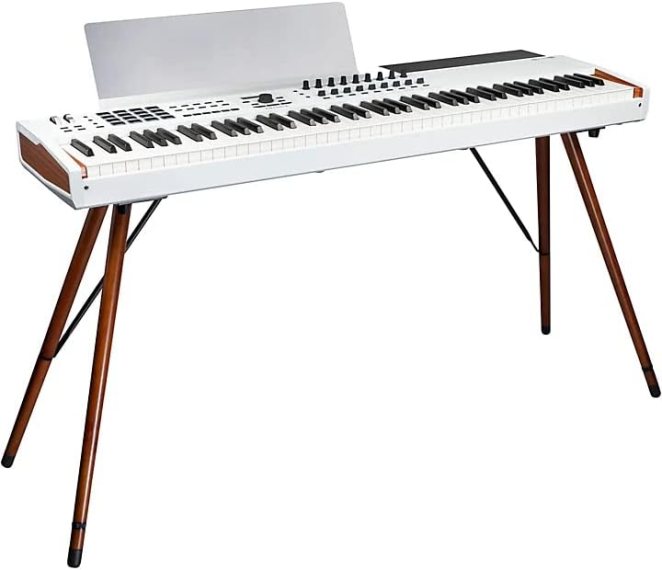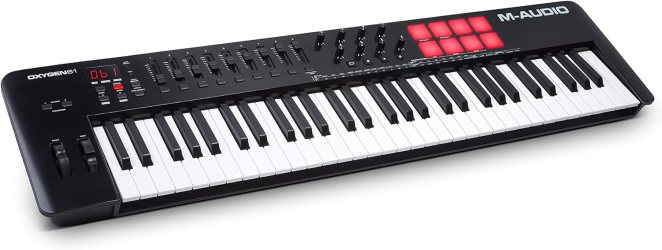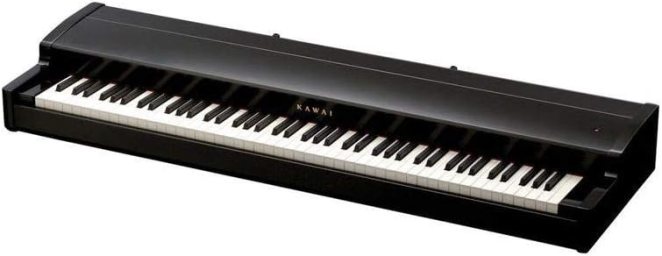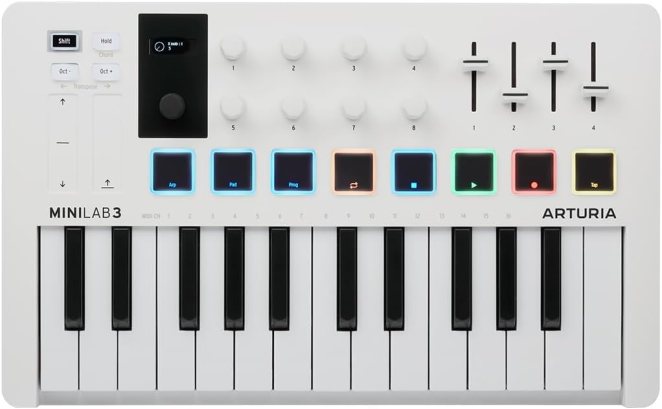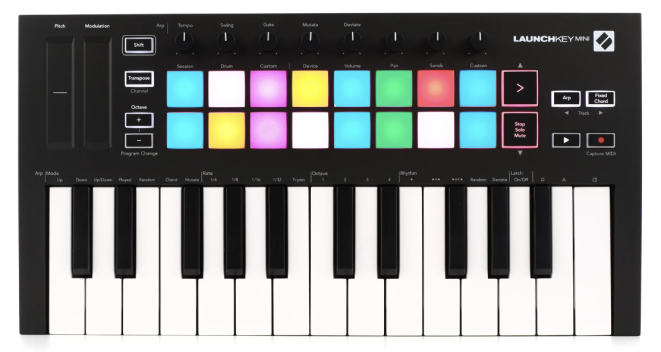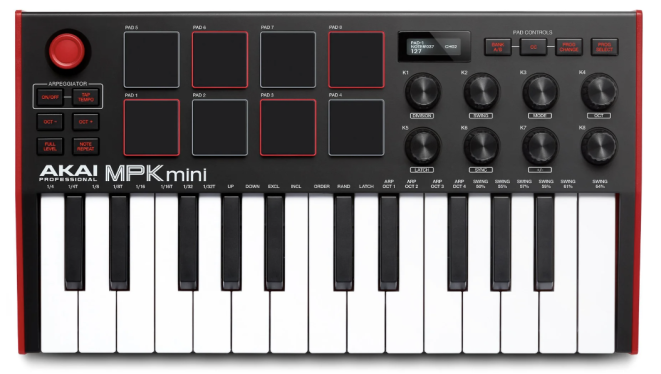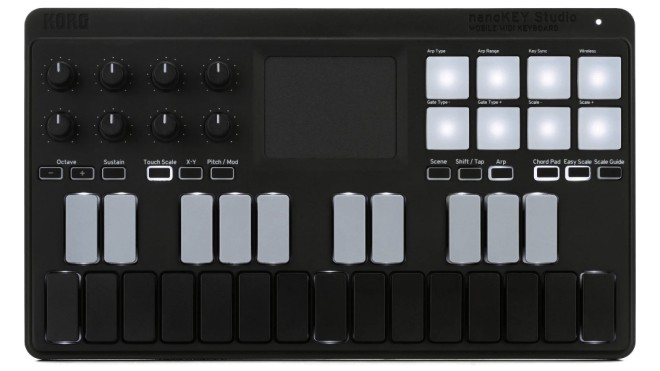The MIDI keyboard is one of the tools that define music production in the 21st century.
A technology that’s been around since the 1980s (I own a 1983 Roland JX-3P with a MIDI port, one of the first with such a feature), MIDI today allows the so-called “bedroom” music producers to deliver music that sounds professional and versatile like major-label productions do.
Choosing the right MIDI keyboard for your needs is no trivial task: there are endless options in terms of size, portability, features, compatibility, and budget. So, how do you choose one that'll streamline your workflow and make the most of your DAW (digital audio workstation)?
Below you’ll find a list of what I believe are the best MIDI keyboards available right now: a mixed bag of portable controllers, piano-like keyboards, and all-in-one solutions for performers and music producers.
My personal pick? The Arturia Keylab 88 MKII is hands down one of the most powerful, versatile, and feature-rich MIDI keyboards in the market right now. But it's not for everyone. So keep on reading to check out my other recommendations!
Quick Summary of the Best Midi Keyboards of 2024
- Arturia Keylab 88 MKII (Best Overall)
- M-Audio Keystation 61 controller (Best For Apple/iPad)
- KAWAI VPC1 VIRTUAL PIANO CONTROLLER(Best Piano-like Experience)
- Arturia MiniLab 3 (Best Budget Pick)
- NOVATION LAUNCHKEY MINI MK3 (Best for Ableton Users)
- NEKTAR IMPACT LX61+ (Best for Non-Ableton Users)
- Akai MPK Mini Mk3 (Best Under $100)
- Native Instruments Komplete Kontrol S88 MK2 (Best Software Bundle)
- M-Audio Oxygen 49 MK IV (Best 49-key Controller)
- Korg nanoKEY Studio (Best with Bluetooth Capability)
Best MIDI Keyboards for Music Production of 2024
Best Overall
The Arturia KeyLab 88 MKII is a professional keyboard controller that provides an authentic grand piano feel along with cutting-edge control features.
SPECS:
- Number of keys: 88
- Weighted: Yes
There’s no doubt in my mind that the KeyLab 88 MKII can upgrade the music-making experience of serious pianists and music producers alike.
This MIDI keyboard offers a realistic response unlike any other, thanks to the high-end Fatar TP100LR 88-note hammer-action keybed and its realistic aftertouch, giving even the most demanding players a tool to express themselves fully.
The KeyLab 88 MKII offers a plethora of connectivity options, from the onboard CV/Gate options to connect analog synths with your setup, to the MIDI 5-pin DIN, USB-MIDI, and auxiliary pedal inputs.
The KeyLab 88 MKII also comes bundled with Arturia's iconic Analog Lab software, which gives you access to over 6,500 synth and keyboard sounds, including physically modeled pianos and the iconic Vox Continental and Wurlitzer 200A electric pianos, all of which can be mapped seamlessly and in no time.
This, and much more, is what makes the KeyLab 88 MKII the best MIDI keyboard controller on this list. For regular keyboards with 88 keys, read our best-selling 88-key weighted keyboards reviews.
What Could Be Improved:
- If you’re looking for a light MIDI key response, look elsewhere.
Best for iPad/iOS
SPECS:
- Number of keys: 61
- Weighted: Yes (semi-weighted)
The Keystation 61 MK3 comes with carefully crafted, semi-weighted, velocity-sensitive keys, which are perfect for both professional piano players and occasional producers. You’ll also find a control set with Pitch, Modulation, and Octave controls and a volume slider that can be assigned to control any MIDI value in the studio.
It also features transport controls and cursor keys, which can streamline your workflow whether you use it live or as a music production tool. It’s a plug-and-play, USB-powered keyboard, meaning you won't need anything but a USB cable for both power and MIDI transmission.
The Keystation 61 MK3 is seamlessly compatible with iPad and iPhone environments: you can pair it with GarageBand or Logic using the Apple Camera Connector, which makes it the perfect travel companion for musicians who want to create on the go.
What Could Be Improved:
- The control layout can’t be customized as much as I’d like.
Best Piano-like Experience
SPECS:
- Number of keys: 88
- Weighted: Yes
The VPC1 gives you the same feel and response as a real grand piano, with a wooden key, graded hammer action, ivory touch, and triple-sensor detection. If your production revolves around piano melodies, this is undoubtedly one of the best MIDI keyboards you can get.
It’s designed to work seamlessly with virtual piano software, hence offering endless options to sculpt your sound. The VPC1 also comes with Kawai's F-30 triple-pedal unit, pre-configured to send messages for damper, soft, and sostenuto playing.
The VPC1 also provides simultaneous USB and MIDI connectivity and comes with customized touch curves for top virtual piano software, further expanding the versatility of this phenomenal keyboard.
What Could Be Improved:
- Ideal only if you play the piano or make piano-based compositions. For anyone else, there are better (and cheaper) options.
Best Budget Pick
SPECS:
- Number of keys: 25
- Weighted: No
The MiniLab 3 comes with two touch sensors for pitch and modulation control, as well as eight touch-and pressure-sensitive RGB-backlit pads that are split into two banks, for a total of 16 fully assignable slots.
I always preferred pads to be in two separate rows, so I can assign different types of instruments (percussions and melodies, for instance) to separate rows. Unfortunately, that’s not possible with this MIDI keyboard.
MiniLab 3’s mini display features a clickable browsing knob that allows you to tweak any one of the MiniLab 3's 500 presets on the go. It’s a plug-and-play MIDI device with custom-written DAW scripts, making it seamlessly compatible with whichever software you use and giving you access to the versatile Analog Lab library.
The connectivity options provided by the MiniLab 3 are quite impressive: it comes with a 5-pin MIDI DIN output, a USB-C port, and a 1/4-inch control input that can be used with your pedal, sustain, expression controller, and more. All in all, the MiniLab 3 is a powerful controller you can carry with you at all times, and even use without your computer, thanks to its vast library and standalone feature.
What Could Be Improved:
- Lack of built-in note repeat function.
Best for Ableton users
With its compact design, powerful features, and easy integration with any DAW (but especially with Ableton), the Novation Launchkey Mini MK3 is a must-have for any music producer.
SPECS:
- Number of keys: 25
- Weighted: No
The Novation Launchkey Mini MK3 is a tiny MIDI keyboard that has it all: 25 mini keys, 16 backlit velocity-sensitive pads to trigger stuff, and eight rotary knobs to customize the tone.
What I love the most about the Novation Launchkey is its Custom Modes, which streamline communication between controller and software and let you customize the behavior of your Launchkey based on your workflow. This feature gives you endless customization options over control assignments, MIDI routing, pad color, and more.
This portable keyboard is designed to work seamlessly with Ableton Live, but it can also be used with virtually all major DAWs, including Logic, Reason, Studio One, Cubase, and Pro Tools.
It comes with a rich software bundle of virtual instruments, plugins, and sample packs that includes Ableton Live 10 Lite, Spitfire Audio LABS Expressive Strings, XLN Audio Addictive Keys, Klevgrand R0Verb and DAW Cassette, and AAS Session Bundle.
While for the price I’d definitely go for other keyboards (Minilab 3 or the Akai MPK Mini Mk3), the Launchkey Mini MK3 is a great option for traveling producers who use Ableton as their main DAW.
What Could Be Improved:
- Feels plasticky.
- No aftertouch option.
Best for Non-Ableton Users
The Nektar Impact LX61+ is a fantastic USB MIDI controller designed to work seamlessly with Bitwig Studio, Cubase, Studio One, and more.
SPECS:
- Number of keys: 61
- Weighted: No
The Nektar Impact LX61+ is a fantastic USB MIDI controller that’s seamlessly compatible with a lot of often-neglected DAWs, so I’d definitely recommend it if you’re a bedroom producer using anything but Ableton Live or Logic Pro. I’ve been using an Impact LX25+ to produce and play live for years and couldn’t be happier with it.
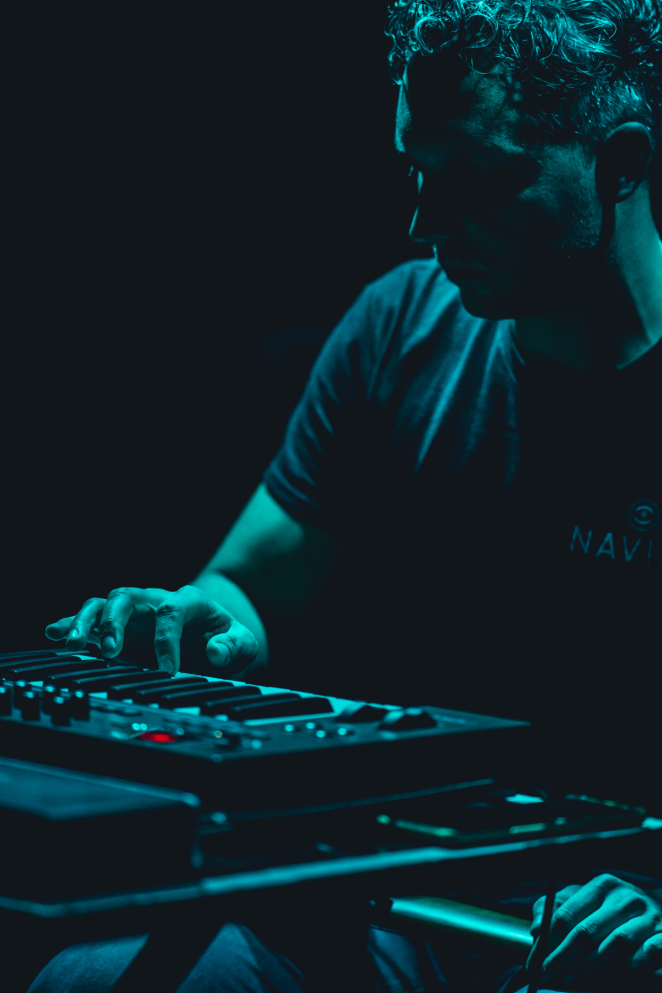
With its intelligent mapping, the Impact LX61+ allows you to switch between Mixer, Instrument, and Preset modes in a second. Everything about this keyboard speaks of upgraded workflow: the faders and encoders are labeled to show default instrument parameter assignments, while the pitch and mod wheels are placed to the left, and the octave and transpose buttons are just above them.
The Nektar Impact LX61+ comes pre-mapped and configured, so you don't have to waste hours assigning MIDI controls. All you have to do is go to Nektar’s website and download the right software to connect the keyboard to your DAW, and you’re all set.
It also comes with the Bitwig 8-Track DAW software: with the entire collection of Bitwig Studio devices, you’ll have enough tools to compose and produce anything that comes to your mind.
What Could Be Improved:
- Ableton users will have a hard time setting it up.
- The keys are a bit too noisy for my taste.
Best under $100
SPECS:
- Number of keys: 25
- Weighted: No
The MPK Mini Mk3 might be small, but it offers everything you need to produce music professionally: 25 velocity-sensitive mini keys, eight backlit, bankable velocity-sensitive MPC-style pads, and eight assignable endless knobs.
It also comes with a 4-way joystick for dynamic pitch/modulation control and dedicated octave up and down buttons. For those switching from a different MIDI keyboard, the joystick might feel a bit awkward at first, but it’s actually super easy to use once you have a grip on its intuitive MIDI control design.
The MPK Mini Mk3 comes with the Complete Music Production Starter Kit, which includes over 1500 sounds and an immense software package that includes MPC Beats and six professional virtual instruments to get you started right away.
What Could Be Improved:
- Plasticky feel.
- I find the keys too narrow and prone to break.
Best Software Bundle
SPECS:
- Number of keys: 32
- Weighted: No
The Komplete Kontrol M32 comes with a rich software bundle that includes Monark monophonic synth, Reaktor Prism polyphonic synthesizer, Scarabee Mark I electric piano, Maschine Essentials, Komplete 14 Start, and an e-voucher for the Native Instruments Store.
This 32-key MIDI keyboard features eight touch-sensitive control knobs, two touch strips, and a four-directional push encoder. Tag-based preset browsing allows you to find sounds quickly and hear instant previews, while Smart Play makes you stay in key with over 100 scales and modes or play chord progressions and arpeggios with single keys.
The Komplete Kontrol M32 is seamlessly pre-mapped with Komplete instruments and effects and Native Kontrol Standard (NKS) plugins via the Komplete Kontrol software. This alone makes it a fantastic tool for composition, especially if you’re already familiar with the potential of NI’s sound library.
What Could Be Improved:
- For an extra $50, you can get the Komplete Kontrol A49, which is far better.
Best 49-key Controller
SPECS:
- Number of keys: 49
- Weighted: Yes (Semi-weighted)
With its Smart Chord and Smart Scale modes, full-featured Arpeggiator, and smooth control over your virtual instruments and effects, the Oxygen Pro 49 is one of the most intuitive controllers you can get for less than $300.
This 49-key controller also includes full-featured Octave, Gate, and Swing controls, as well as DAW transport controls, ergonomic pitch-bend and mod wheels, a sustain pedal input jack, 5-pin MIDI out, and USB-MIDI. This makes it a versatile tool you can use inside your studio as well as on stage.
Speaking of software bundles, the Oxygen Pro comes with MPC Beats and Ableton Live Lite DAW, as well as a generous virtual instrument plugin and MPC expansion pack that includes various synths, including Hybrid 3, Velvet, Mini Grand (acoustic piano), Vacuum, Boom (drum machine), DB-33, and many more.
What Could Be Improved:
- Eight pads might not be enough for those who use plenty of loops.
Best with Bluetooth
SPECS:
- Number of keys: 25
- Weighted: No
I started making music with the first nanoKEY, years ago, so reviewing its upgraded version brings back a lot of good memories.
The new nanoKEY Studio comes with 25 keys, eight velocity-sensitive pads, eight knobs, and a KAOSS-style X-Y pad. The keyboard’s super-efficient Bluetooth LE connectivity makes it the perfect choice for musicians who don’t want to carry around extra cables.
Despite its size, the nanoKEY Studio comes with plenty of functions, including keys for Chord Pad and Easy Scale. It also includes a software bundle for Mac, PC, and iOS platforms, including Reason Lite, so you can get started right away without the need to buy more plugins.
What Could Be Improved:
- It takes time to get used to the keys (performing live with it might be a pain).
Buyer’s Guide
So, now that you have gone through the list of my favorite MIDI keyboards, it's time to discuss how you can choose one that fits your budget and needs.
I think the best way to tackle this is by identifying what you need the MIDI keyboard for: to make music in your studio? Take it with you while you’re traveling? Is it to perform live?
Next, define what kind of music producer you are. Are you a film scorer? A hip-hop beatmaker? A songwriter who likes to add some electronic music when playing live?
Focusing on these questions will help you narrow down your search and opt for a MIDI keyboard that can truly help you express yourself.
Let’s analyze each element to consider when buying a new MIDI keyboard.
Key Count/Size
If you're looking for a keyboard that's easy to carry around, a model with 25 or 32 keys is your best bet. Nowadays, many compact models come with a plethora of effects that can help you sculpt sounds professionally, so a 25-key MIDI controller might well be all that you need.
However, if you want to create more complex pieces of music, you’ll probably need a larger keyboard with 49, 61, or 88 keys. If you're a piano player, a classical composer, or a film scorer, chances are that having a 25-key MIDI keyboard will add stress to your workflow more than anything else.
MIDI Controls
Usually, MIDI keyboards come with plenty of knobs, faders, buttons, and pads. Each keyboard has a different configuration, which may or may not work well with your workflow.
Do you use plenty of samples and loops? Then you need 8 or even 16 sensitive pads, but you might not be interested in control knobs. Do you make ambient music? Then you’ll probably want as many control knobs as you can get, and you might consider the pads as an afterthought.
Take time to understand what you need when you compose and perform, and it’ll become clearer which MIDI keyboard can best fit your genre and style.
Touch Sensitivity
Most players, including me, consider having touch-sensitive keys a necessity. However, that’s not the case for everyone: if you’re a beatmaker, I’m sure touch sensitivity is not your main priority.
Once again, think about whether you need this feature or not, as touch sensitivity might lead you into a rabbit hole where finding the right keyboard might take a very, very long time.
Software Integration
Some keyboards are designed to work seamlessly with specific software. They offer a plug-and-play experience and pre-mapped controls, which makes it super intuitive and stress-free to get started. I remember when I bought my LX25+ last year, and how it connected right away with Studio One: it was such a relief!
Choose the keyboard based on the software bundle it comes with, as well as its compatibility with your current setup. For the latter, you can check the manufacturer’s website, but I’d also recommend Reddit to hear about real-life hands-on experiences.
Aftertouch
Aftertouch is a feature I love. It detects the pressure applied to keys after they’re initially pressed and can be used to control effects like vibrato, volume, and filter sweeps.
If you work in classical music, aftertouch is a must, and it does wonders when you want to add realism to a virtual instrument. Consider getting a keyboard with such a feature if you want to make your instruments sound as natural and authentic as possible.
Connectivity
USB connectivity is standard, but most keyboards nowadays offer more than just USB ports: MIDI Out/In, CV/Gate, sustain pedal inputs, and even Bluetooth.
Choose one according to your gear (musical instruments and audio interface) and how you’re planning to use your MIDI keyboard. If it’ll become a main component of your recording practices, the more connectivity options, the better. Top-rated keyboards for music production offer the most versatile connectivity option by far.
Power Supply
Most MIDI keyboards are powered via USB when connected to a computer. However, if you plan to use the keyboard with standalone synths, drum machines, or without a computer, the power supply becomes a crucial aspect to consider.
Some models need batteries or an AC adapter, so if you use it live, make sure you’ll be able to power your MIDI keyboard while on stage.
FAQ
What is the difference between weighted and semi-weighted keys?
Weighted keys offer the same resistance and feel as an acoustic piano, while semi-weighted keys have a lighter touch compared to weighted keys and use springs rather than actual weights, providing some resistance without the full weight of piano keys.
Can I connect my MIDI keyboard to my iOS or Android device?
Yes, many MIDI keyboards can connect to iOS and Android devices, but you might need extra cables.
For iOS devices, chances are you'll need a Lightning to USB Camera Adapter (for devices with Lightning ports) or a USB-C to USB Adapter. For Android devices, an OTG cable will do the job.
Are there any MIDI keyboards available with Bluetooth connectivity?
Yes, there are MIDI keyboards with Bluetooth connectivity, like the aforementioned Korg nanoStudio. This feature allows you to connect the keyboard wirelessly to your computer, tablet, or smartphone, providing a cable-free (and stress-free) setup.
Can I use this MIDI keyboard for both studio recording and live performances?
You can use any MIDI keyboard both in the studio and on stage, but some are better suited for either one or the other environment.
For recording sessions, a MIDI keyboard can be used to compose, record, and produce music using virtual instruments. On stage, MIDI keyboards can trigger samples, play virtual instruments, or control synthesizers.
If you’re planning to use a MIDI keyboard for both purposes, think about its portability and the range of controls it offers to ensure it satisfies your needs in both environments.
Final Thoughts
I hope this guide will help you make a conscious decision when buying your next MIDI controller. The best MIDI keyboard controllers, like the Arturia Keylab 88 MKII, are empowering tools that can take your artistry to the next level, with endless features and the versatility you need to create your unique sound signature.
A valid and inexpensive alternative is the Akai MPK Mini Mk3: tinier than most MIDI controllers, but with plenty of customization options, seamless compatibility, and a good software bundle, it can be a great first step into the world of music production.
